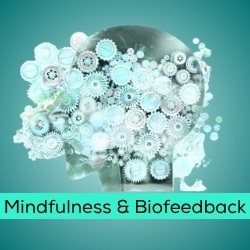Mindfulness and Biofeedback
Overview
Mindfulness is a meditative or therapeutic technique that engages the individual in his or her awareness of the present moment. It is particularly relevant in terms of their ability to recognize their own present feelings and reactions to events around them. When considering biofeedback and its goal of building awareness of an individual’s own psychophysiological reactions, via breathing, heart rate, muscle tension, temperature and sweating, it is not surprising that mindfulness and biofeedback are two fields that “marry” well together. Mindfulness and biofeedback both offer individuals helpful ways to respond to difficult emotions and physical pain. When asked about the benefits of combining the two methods, Dr. Inna Khazan explained, “Mindfulness enables us to pause long enough to make a choice of response. Skills learned through biofeedback are a large part of that chosen response.”
The BFE’s current offerings are the results of an on-going collaboration with Dr. Khazan, which we believe represent a clear and straight-forward method for clinicians to combine biofeedback and a mindfulness-based approach.
BFE Mindfulness & Biofeedback Software Suite
 This software package is designed by Inna Khazan, Ph.D., as a tool for any clinician that desires to establish a biofeedback practice with a mindfulness acceptance-based approach. The software is based on the instructions of Dr. Khazan’s book The Clinical Handbook of Biofeedback: A Step-by-Step Guide for Training and Practice with Mindfulness and is an excellent companion tool for quickly enacting her clinical method. All aspects of the Mindfulness suite have been personally tested in Dr. Khazan’s private practice, a testament to exacting expectations.
This software package is designed by Inna Khazan, Ph.D., as a tool for any clinician that desires to establish a biofeedback practice with a mindfulness acceptance-based approach. The software is based on the instructions of Dr. Khazan’s book The Clinical Handbook of Biofeedback: A Step-by-Step Guide for Training and Practice with Mindfulness and is an excellent companion tool for quickly enacting her clinical method. All aspects of the Mindfulness suite have been personally tested in Dr. Khazan’s private practice, a testament to exacting expectations.
The Mindfulness Suite includes the following:
- Psychophysiological stress profile assessment with automatic graphing of results into an easy-to-read excel report.
- Relaxation profile assessment for evaluation of the individual’s ability to recover and utilize various relaxation or meditative technique in self regulation. The assessment includes an automated excel report that translates relevant data into easy-to-read graphs.
- Choice of resonance frequency evaluations for individuals of different heights, since RF breathing rates are height dependent:
- Child assessment with higher respiration rates;.
- Assessment for taller individuals with lower respiration rates; and.
- The traditional RF assessment with automatic graphing of results, to simplify data analysis.
- Working-at-a-Computer assessment with an automated Excel reporting function. This assessment follows Dr. Erik Pepper’s template for an effective way to evaluate EMG and breathing activity for individuals who spend significant time working at the computer and experience muscle pain and tension.
- TMJD assessment of muscle function for individuals affected by Temporomandibular Joint Disorder. This assessment allows clinicians to chose from a variety of TMJ activities that are most relevant to each individual client for a comprehensive overview of each individual’s muscle function.
- Simple Baseline recording with an automated excel report to allow clinicians an easy way to record baseline measurements from all peripheral modalities (heart rate, heart rate variability, breathing, muscle tension, temperature, and skin conductance) and receive an Excel report to summarize recorded data.
- Pre-grouped monitoring and training screens, that follow Dr. Khazan’s style of biofeedback training. Data is obtained from muscle tension, respiration, heart rate (BVP or EKG), skin conductance and temperature. The display screens are for 1 or 2-monitor setups.
Documentation in the form of a software manual that instructs the users how to make use of all technical aspects of the equipment, sensor, and software setup, as well as sample client data. The software manual references the specific chapters and pages of Dr. Khazan’s book for relevant clinical information.
In order to encourage the success of other clinicians, Dr. Khazan has included several relaxation text scripts to be used with clients during the relaxation profile assessment.
An added benefit of the Mindfulness suite is its visually appealing and soothing design for displaying biofeedback data, which any clinician and client will appreciate. This also includes new, sharp animations/videos for feedback.
About Dr. Inna Khazan
 Inna Khazan, PhD, BCB is a faculty member at Harvard Medical School, where she teaches and supervises trainees. She is a clinical psychologist specializing in health psychology and performance excellence training using biofeedback and mindfulness-based approaches. Dr. Khazan is the founder of Boston Center for Health Psychology and Biofeedback, working with clients on optimizing their health and performance. She also serves as chief science officer for Optimal HRV, a company dedicated to helping people improve their mental and physical health.
Inna Khazan, PhD, BCB is a faculty member at Harvard Medical School, where she teaches and supervises trainees. She is a clinical psychologist specializing in health psychology and performance excellence training using biofeedback and mindfulness-based approaches. Dr. Khazan is the founder of Boston Center for Health Psychology and Biofeedback, working with clients on optimizing their health and performance. She also serves as chief science officer for Optimal HRV, a company dedicated to helping people improve their mental and physical health.
Recognized as a pioneer in mindfulness-based biofeedback, Dr. Khazan is a popular speaker at national and international conferences on the topics of biofeedback and mindfulness. She has conducted biofeedback and mindfulness trainings for notable institutions in the US and abroad, including the US Navy Special Warfare, US Army Special Forces, and the Stuttgart Opera and Ballet Company.
Dr. Khazan serves as president of the board of directors for the Association for Applied Psychophysiology and Biofeedback (AAPB), chair elect for Biofeedback Certification International Alliance (BCIA), and is past-president of the board of directors for the Institute for Meditation and Psychotherapy (IMP).
Dr. Khazan writes for Psychology today, is the author of numerous journal articles and several books, including the highly-regarded Clinical Handbook of Biofeedback: A Step-by-Step Guide to Training and Practice with Mindfulness, the popular Biofeedback and Mindfulness in Everyday Life: Practical Solutions for Improving Your Health and Performance, and the most recent The Heart(beat) of Business: Positioning Heart Rate Variability as a Competitive Advantage. She is also lead editor for the newly released 4th edition of Evidence-Based practice in Biofeedback and Neurofeedback.


